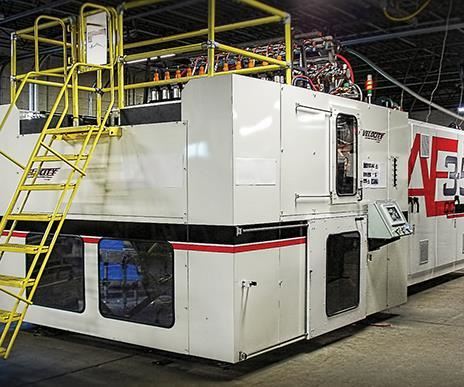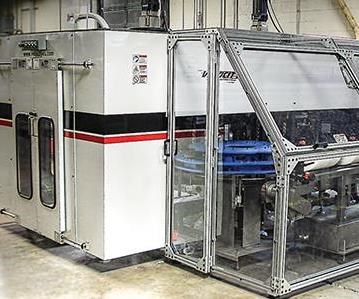New Name in Blow Molding Machinery Promises Gains for Dairy Bottles
Reciprocating-screw machines and impact trimmers get energy-saving electric drive and quick-change features.
A long-time aftermarket supplier of equipment, parts, tooling, and rebuild services for blow molding HDPE containers has realigned its business to focus on supplying its new designs for all-electric, reciprocating-screw extrusion blow machines and servo-driven impact trimmers. Velocity Equipment Solutions, LLC, New Castle, Pa., was formed in 2010 by purchasing the Equipment Div. from Portola Packaging. That division built filling, sorting, capping, and labeling equipment for Portola, as well as molds and spare parts for tooling and for reciprocating-screw machines, which have a long record as workhorses for making HDPE and PP bottles for milk, detergents, and other high-volume products. Portola also started building reciprocating-screw machines for internal use back in 2005. (Portola Packaging was bought by Silgan in 2013.)
Today, Velocity continues most of the activities of the former Portola division, along with equipment for washing, filling, and capping 5-gal polycarbonate water bottles. Tooling is a relatively small part of its business today, but Velocity is shifting resources to commercialize its new blow molding machine and trimmer. It is even looking into acquiring a new building, according to Tom Blaszkow, president.
WHY GO ALL-ELECTRIC?
Blaszkow says his firm has more than 30 years’ experience in maintaining and upgrading reciprocating-screw machines, and is therefore well aware of their strengths and limitations. Three years ago, Velocity was approached by a customer, Nampak Plastics Europe Ltd. Nampak, which does business in 35 countries, is a leading producer of dairy bottles in the U.K. and operates dozens of reciprocating-screw machines. Nampak was looking for new technology—in particular, for the ability to change over from one bottle to another within an 8-hr shift, a fraction of the time usually required.
Blaszkow had another goal—to reduce the operating cost of the machines. Velocity’s new all-electric model—said to be the first in the world—utilizes half the energy of hydraulic models, he says, but that is only one benefit. The other is a 75% reduction in maintenance cost by eliminating frequently maintained components such as hydraulic systems, ball splines, and thrust assemblies. The electric systems are also quieter (below 75 dB).
And there’s more: “We wanted to take the black art out of blow molding,” says Blaszkow. “Electric machines are more repeatable. Hydraulic positioning allows for some slack.” More uniform clamping also leads to better trimming in the molds. “Dairies are moving to lightweight bottles, which are harder to trim. Existing machines are maxing out their clamp force to define the flash on the mold. By contrast, our new machines operate at about 50% of rated clamp force, which leads to longer mold life and allows for higher cavitation than hydraulic reciprocating-screw machines.”
For example, he says his electric presses can take 24 cavities for a 2-pint container, while 10 to 12 cavities “would be a lot for a hydraulic machine.” Likewise, the electric presses reportedly can mold 10-12 dairy gallons, vs. eight for the largest hydraulic machines. Blaszkow adds that these comparisons are at the same cycle times. As a result, he claims, “In some cases, a molder can eliminate two to three hydraulic machines—and all the associated downstream equipment—with one electric machine.”
The new presses are comparable in cost to a similarly sized and configured hydraulic machine, “well within 10%,” according to Blaszkow. The advantage is in substantially lower operating costs.
Nampak has been operating the first developmental model of Velocity’s new design for a little over a year. It reportedly has fulfilled the goal of quick changeovers, allowing a switch from a 4-pint/2.3L lightweight (35-g) bottle on 10 heads to a 2-pint/1.1L, 22-g bottle on 12 heads in 8 hr. Blaszkow says that compares to a couple of weeks for a hydraulic machine—prohibitively long downtime that makes such changeovers impractical. He notes that the head on his new machines can be exchanged in less than 1 hr, and conveyors and takeout systems also have quick-change features.
NEW ELECTRIC TRIMMER HAS CLEANER DESIGN
A second fruit of Velocity’s joint development program with Nampak is a new, servo-driven impact trimmer. As explained by Blaszkow, typical rotary trimmers locate the gears and mechanical components underneath the cutter, where falling trim scrap can cause interference. “They need wipers, brushes, or air blasts to deflect scrap away and keep the gears clean.”
Velocity’s new electric model has the servo drive on top of each rotating head, and the area underneath the head is completely open for the large scrap funnel. Although the trim tooling travels in a rotary motion, the actual trimming is a conventional impact trim. The male tool strikes the female tool head-on, “like a standard impact trimmer, but faster,” says Blaszkow. As a result, this machine reportedly is capable of very high speeds—up to 160 bottles/min—while allowing for a wide operating window. In contrast, Blaszkow says, the male and female tools in some other trimmers meet on a tangent for a “scissors action” that can sometimes leave the flash folded over rather than sliced off.
Quick change is another feature of the new unit, which is designed to change from one container to another within an 8-hr shift.
Related Content
Best Methods of Molding Undercuts
Producing plastics parts with undercuts presents distinct challenges for molders.
Read More‘Monomaterial’ Trend in Packaging and Beyond Will Only Thrive
In terms of sustainability measures, monomaterial structures are already making good headway and will evolve even further.
Read MoreSolve Four Common Problems in PET Stretch-Blow Molding
Here’s a quick guide to fixing four nettlesome problems in processing PET bottles.
Read MoreAutomotive Awards Highlight ‘Firsts,’ Emerging Technologies
Annual SPE event recognizes sustainability as a major theme.
Read MoreRead Next
Making the Circular Economy a Reality
Driven by brand owner demands and new worldwide legislation, the entire supply chain is working toward the shift to circularity, with some evidence the circular economy has already begun.
Read MoreRecycling Partners Collaborate to Eliminate Production Scrap Waste at NPE2024
A collaboration between show organizer PLASTICS, recycler CPR and size reduction experts WEIMA and Conair will seek to recover and recycle 100% of the parts produced at the show.
Read More









 (2).jpg;maxWidth=300;quality=90)
















